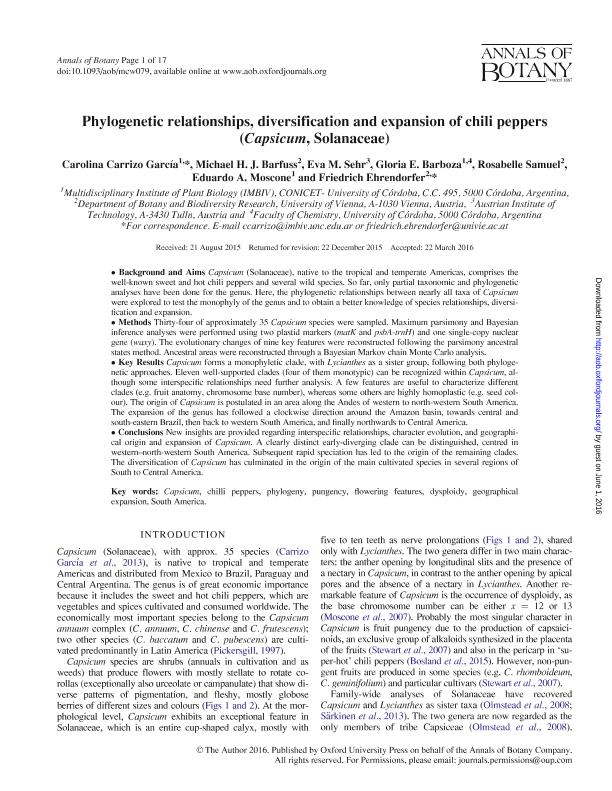Mostrar el registro sencillo del ítem
dc.contributor.author
Carrizo Garcia, Carolina

dc.contributor.author
Barfuss, Michael H. J.
dc.contributor.author
Sehr, Eva M.
dc.contributor.author
Barboza, Gloria Estela

dc.contributor.author
Samuel, Rosabelle
dc.contributor.author
Moscone, Eduardo Alberto

dc.contributor.author
Ehrendorfer, Friedrich
dc.date.available
2017-08-29T17:03:35Z
dc.date.issued
2016-03
dc.identifier.citation
Carrizo Garcia, Carolina; Barfuss, Michael H. J.; Sehr, Eva M.; Barboza, Gloria Estela; Samuel, Rosabelle; et al.; Phylogenetic relationships, diversification and expansion of chili peppers (Capsicum, Solanaceae); Oxford University Press; Annals of Botany; 118; 1; 3-2016; 35-51
dc.identifier.issn
0305-7364
dc.identifier.uri
http://hdl.handle.net/11336/23245
dc.description.abstract
Background and AimsCapsicum (Solanaceae), native to the tropical and temperate Americas, comprises the well-known sweet and hot chili peppers and several wild species. So far, only partial taxonomic and phylogenetic analyses have been done for the genus. Here, the phylogenetic relationships between nearly all taxa of Capsicum were explored to test the monophyly of the genus and to obtain a better knowledge of species relationships, diversification and expansion.
Methods Thirty-four of approximately 35 Capsicum species were sampled. Maximum parsimony and Bayesian inference analyses were performed using two plastid markers (matK and psbA-trnH) and one single-copy nuclear gene (waxy). The evolutionary changes of nine key features were reconstructed following the parsimony ancestral states method. Ancestral areas were reconstructed through a Bayesian Markov chain Monte Carlo analysis.
Key ResultsCapsicum forms a monophyletic clade, with Lycianthes as a sister group, following both phylogenetic approaches. Eleven well-supported clades (four of them monotypic) can be recognized within Capsicum, although some interspecific relationships need further analysis. A few features are useful to characterize different clades (e.g. fruit anatomy, chromosome base number), whereas some others are highly homoplastic (e.g. seed colour). The origin of Capsicum is postulated in an area along the Andes of western to north-western South America. The expansion of the genus has followed a clockwise direction around the Amazon basin, towards central and south-eastern Brazil, then back to western South America, and finally northwards to Central America.
Conclusions New insights are provided regarding interspecific relationships, character evolution, and geographical origin and expansion of Capsicum. A clearly distinct early-diverging clade can be distinguished, centred in western–north-western South America. Subsequent rapid speciation has led to the origin of the remaining clades. The diversification of Capsicum has culminated in the origin of the main cultivated species in several regions of South to Central America.
dc.format
application/pdf
dc.language.iso
eng
dc.publisher
Oxford University Press

dc.rights
info:eu-repo/semantics/openAccess
dc.rights.uri
https://creativecommons.org/licenses/by-nc-sa/2.5/ar/
dc.subject
Capsicum
dc.subject
Chilli Peppers
dc.subject
Phylogeny
dc.subject
Pungency
dc.subject.classification
Bioquímica y Biología Molecular

dc.subject.classification
Ciencias Biológicas

dc.subject.classification
CIENCIAS NATURALES Y EXACTAS

dc.title
Phylogenetic relationships, diversification and expansion of chili peppers (Capsicum, Solanaceae)
dc.type
info:eu-repo/semantics/article
dc.type
info:ar-repo/semantics/artículo
dc.type
info:eu-repo/semantics/publishedVersion
dc.date.updated
2017-08-18T21:35:31Z
dc.identifier.eissn
1095-8290
dc.journal.volume
118
dc.journal.number
1
dc.journal.pagination
35-51
dc.journal.pais
Reino Unido

dc.journal.ciudad
Oxford
dc.description.fil
Fil: Carrizo Garcia, Carolina. Consejo Nacional de Investigaciones Científicas y Técnicas. Centro Científico Tecnológico Conicet - Córdoba. Instituto Multidisciplinario de Biología Vegetal. Universidad Nacional de Córdoba. Facultad de Ciencias Exactas Físicas y Naturales. Instituto Multidisciplinario de Biología Vegetal; Argentina
dc.description.fil
Fil: Barfuss, Michael H. J.. Universidad de Viena; Austria
dc.description.fil
Fil: Sehr, Eva M.. Austrian Institute of Technology; Austria
dc.description.fil
Fil: Barboza, Gloria Estela. Consejo Nacional de Investigaciones Científicas y Técnicas. Centro Científico Tecnológico Conicet - Córdoba. Instituto Multidisciplinario de Biología Vegetal. Universidad Nacional de Córdoba. Facultad de Ciencias Exactas Físicas y Naturales. Instituto Multidisciplinario de Biología Vegetal; Argentina
dc.description.fil
Fil: Samuel, Rosabelle. Universidad de Viena; Austria
dc.description.fil
Fil: Moscone, Eduardo Alberto. Consejo Nacional de Investigaciones Científicas y Técnicas. Centro Científico Tecnológico Conicet - Córdoba. Instituto Multidisciplinario de Biología Vegetal. Universidad Nacional de Córdoba. Facultad de Ciencias Exactas Físicas y Naturales. Instituto Multidisciplinario de Biología Vegetal; Argentina
dc.description.fil
Fil: Ehrendorfer, Friedrich. Universidad de Viena; Austria
dc.journal.title
Annals of Botany

dc.relation.alternativeid
info:eu-repo/semantics/altIdentifier/url/https://academic.oup.com/aob/article-lookup/doi/10.1093/aob/mcw079
dc.relation.alternativeid
info:eu-repo/semantics/altIdentifier/doi/http://dx.doi.org/10.1093/aob/mcw079
Archivos asociados
